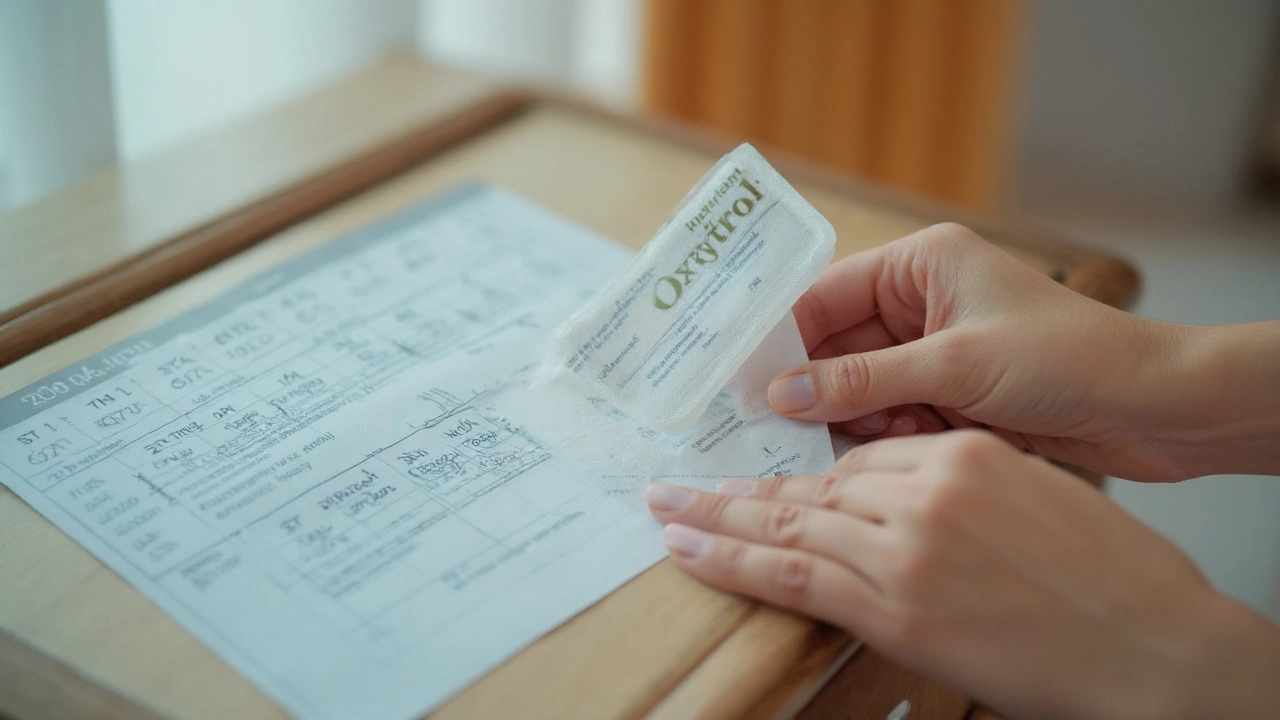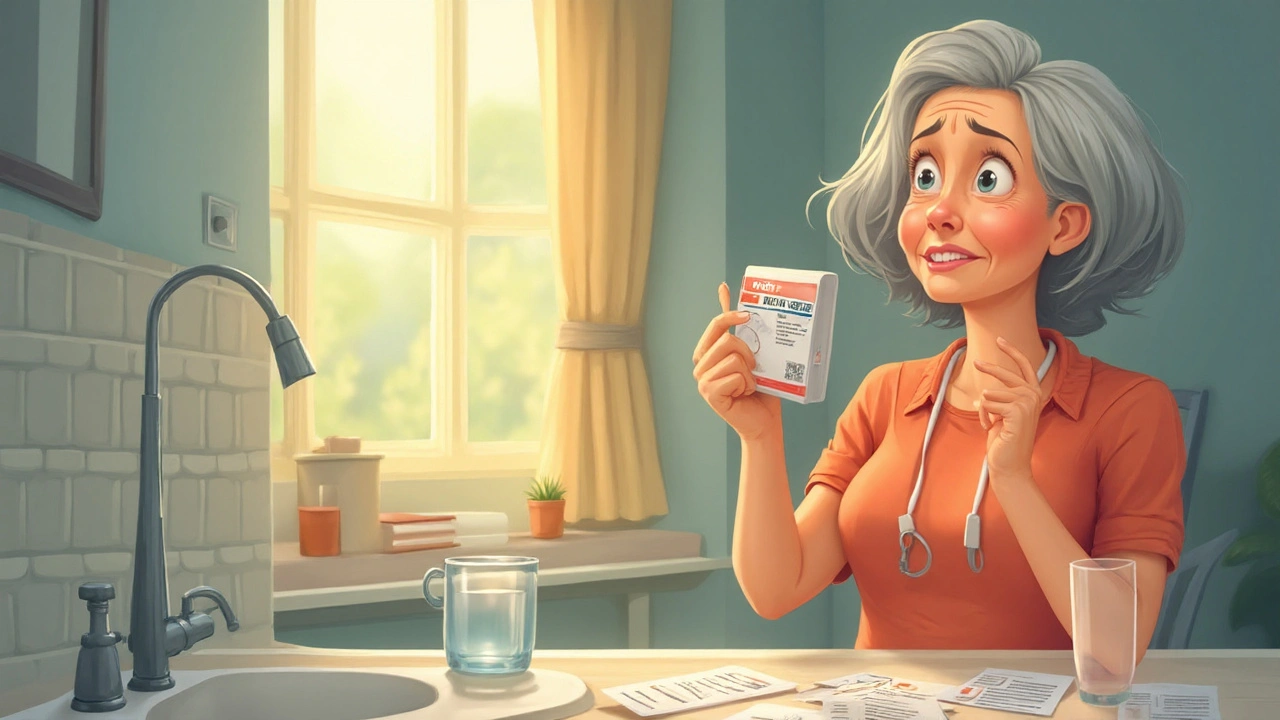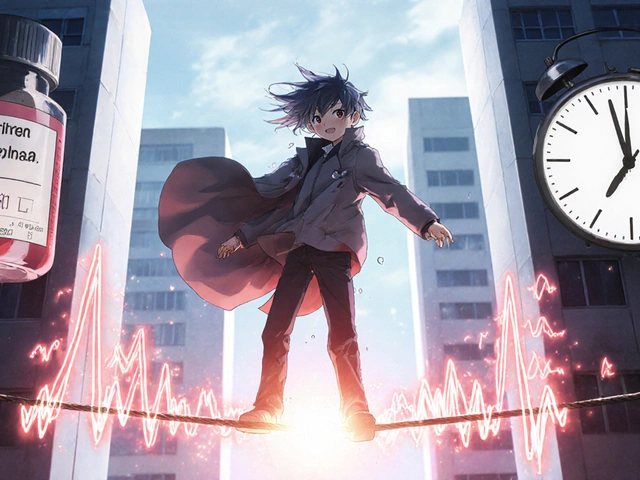Ever had your bladder boss you around? Oxytrol is a game-changer for folks who find themselves always looking for a bathroom or waking up at night just to pee. Overactive bladder (OAB) is not just a quirky inconvenience—it's something that can wreck your confidence, nuke your daily plans, and leave you constantly anxious about the next bathroom break. No one wants to feel chained to a toilet. That’s where Oxytrol steps in and makes some serious difference.
What is Oxytrol and How Does It Work?
Oxytrol is a medicated patch, not a pill. That in itself is pretty cool, since you just slap the patch on and forget about it for a few days. The magic ingredient here is oxybutynin, which is an anticholinergic. That's basically a fancy way to say it relaxes your bladder muscle, cutting down those spasms that cause you to rush to the bathroom—and sometimes not make it in time. The patch slowly releases the medication through your skin, which keeps your bladder on its best behavior around the clock.
Instead of tossing more pills into your system and dealing with possible stomach upset, you apply Oxytrol to your abdomen, hips, or buttocks about every four days. Once it’s on, you don’t really have to think about it. The patch is clear, flat, and just sticks comfortably to your skin. If you’ve ever worn a nicotine patch, the idea is similar. For many people, this is more discreet and simple than managing pills or trying invasive treatments.
| Key Facts about Oxytrol | Details |
|---|---|
| Form | Transdermal patch |
| Main ingredient | Oxybutynin |
| Prescription | Rx for men, OTC for women (in the US) |
| Dose | One patch every 4 days |
| Common side effects | Dry mouth, skin irritation, constipation |
| Onset | May take a few days to notice effects |
One quirky fact: Oxytrol is available over-the-counter for women in the US. For men, though, it’s prescription-only, usually because doctors want to make sure bladder problems aren’t linked to a prostate issue. So if you’re a woman battling leaks, you can pretty much pick it up at your local pharmacy. That’s a rare convenience in the world of prescription drugs. According to sales data from 2024, Oxytrol was one of the top-selling OTC bladder patches among adult women, showing that it’s not just clinically proven but genuinely popular among real people who struggle with OAB.
This patch is designed for adults—kids aren’t in the target group. Also, it’s not a magic fix for urinary tract infections, kidney disease, or certain types of bladder blockages. Oxytrol sticks to bladder overactivity. That's it. Studies from 2022 showed a 60% reduction in sudden urgency episodes for those using Oxytrol compared to a placebo. Pretty legit.

Who Should Use Oxytrol and What Should You Expect?
Let’s be honest—lots of people need bladder help, but not everyone wants to talk about it. If you’re peeing more than 8 times a day, getting sudden urges that force you into awkward sprints, or leaking before you even get to the bathroom, Oxytrol could be a solid match. It’s helpful for women dealing with post-pregnancy bladder changes, guys after middle age, and even those just unlucky in the bladder lottery.
Your experience might go something like this: You start wearing the patch and, after 2 or 3 days, you realize you’re not making as many panic dashes to the restroom. A lot of users report that night-time urgency fades away, so sleep gets way better. If you’re doing the math, that’s a straight-up life upgrade—especially if you measure your life in terms of how many hours you spend NOT awake at 3 AM.
The patch is easy to mess up if you don’t read the directions, though, so pay attention. Here are a few solid-use tips:
- Peel and stick on clean, dry, hairless skin—avoid using it right after a shower.
- Swap to a different spot each time, or you’ll get some gnarly skin irritation.
- Don’t stick it on skin that’s broken, red, or sunburnt.
- Write the date on each patch so you never forget when to change.
Wondering how long you’ll need to use Oxytrol? There’s no set end-date unless your doctor says so. Most folks keep it going for months, even years, as long as the results hang around and there aren’t too many side effects. Some people get dry mouth, slight blurry vision, or mild constipation. About 16% report itching where the patch sits, but moving it around usually fixes that. If you get hives or breathing issues (super rare), your body’s throwing a red flag and you should call your doc ASAP.
Here’s a money-saving hack: if you switch up the patch site every time (abdomen, hip, lower back, buttocks), you’re less likely to get skin issues and the patch will stick better. Also, skip lotions or powders near the patch—those mess with the adhesive.
If you’re on other medications, give your doctor a heads-up. Oxytrol can sometimes mess with certain allergy drugs, antidepressants, and meds that dry you out. People with glaucoma, severe constipation, or severe liver issues may need to skip this altogether. And if you’re pregnant or breastfeeding, only use Oxytrol if your doctor approves—it hasn’t been deeply studied in those groups.
People often worry about urine retention—a rare but real side effect, where the bladder just refuses to empty right. If you start feeling bloated, can’t pee, or your pee stream is suddenly a trickle, stop using the patch and get checked out.

Living with Overactive Bladder: Facts, Hacks, and Real-World Experience
Overactive bladder impacts 1 in 6 adults worldwide, and more than 30 million Americans deal with it at any given time. Those are not small numbers. OAB isn’t just about leaks—it wrecks travel plans, kills fun nights out, and makes you paranoid that every laugh or sneeze will turn into an accident. Stress makes it worse, but so do some food and drink favorites: coffee, spicy food, tomato sauces, even citrus fruits can poke at your bladder. Many people find that simple tweaks—like regular bathroom breaks, pelvic floor exercises, and drinking water slowly—add up to a real difference when combined with Oxytrol.
If you want the full arsenal, here’s what people actually find useful, according to several patient forums and clinical reports:
- Combine the patch with bladder “training”—create a schedule for bathroom visits and stick to it, stretching the time out bit by bit.
- Avoid “just-in-case” pee trips. They train your bladder to want more frequent emptying and make urgency worse over time.
- Set reminders for patch changing days—seriously, who’s going to remember every 4 days otherwise?
- Wear breathable clothes and underwear, especially during hot months, since sweat can loosen the patch.
- Drink water, but sip throughout the day. Chugging big bottles in one go tends to make OAB symptoms pop up worse.
Here’s an odd tidbit: around 24% of Oxytrol users noticed way fewer leaks but only when they paired the patch with daily walks or light exercise. No one’s exactly sure why—better pelvic muscle tone, maybe?—but the combo seems to be a winner.
Insurance can be a headache, honestly. OTC Oxytrol for women is usually not reimbursed, but prescriptions for men often are. Prices in 2025 run around $35 to $55 for a box of 8 patches in most US states, but sales and manufacturer coupons can halve that cost. Online reviews from June 2025 say the patches are often out of stock at smaller pharmacies, so it’s smart to call ahead or use a big-chain pharmacy for better luck.
It’s wild that something as easy as a patch could give people a slice of normal life back. Less stress, more freedom, no more embarrassing “gotta pee” moments. That’s kind of the dream if you’ve been living with an unpredictable bladder. Oxytrol isn’t for everyone, but for the right person, it can mean that first worry-free concert or a road trip that doesn’t revolve around rest stops. That’s big. If you’re tired of letting your bladder run the show, a clear little patch might be your ticket to a calmer, more confident life.








Jefferson Vine
August 13, 2025 AT 20:00Okay, first off — I appreciate the write-up, but people need to wake up to the bigger picture here.
This patch is convenient, sure, but why is it OTC for one sex and prescription for another? Pharma and regulators love carve-outs. They get these little market monopolies and everyone pays more in the long run. It’s classic: make it over-the-counter for a huge demographic so sales surge, keep the smaller demographic behind the prescription counter so doctors keep getting paid and companies keep collecting data. Data = power.
Also, transdermal delivery is brilliant for steady dosing, but it hides a lot of systemic exposure. Oxybutynin is an anticholinergic — that class has long-term cognitive concerns especially in older adults. Patch or pill, the drug still gets into the system. We should be scrutinizing long-term studies, not just trusting the marketing spiel.
I’ve seen the “60% reduction” stat quoted before — nice headline, but what’s the absolute risk reduction? What were the baseline frequencies? Were there washouts for prior meds? Without that context the number is just noise for headlines.
Final note: if someone’s suddenly peeing way more, get the prostate and kidneys checked. Too many people slap on symptomatic fixes and miss something structural.
Anyway, the patch is useful for many, but keep your guard up about incentives and incomplete data.
Donna Oberg
August 30, 2025 AT 03:13I can't believe how many little things about this got me nodding SO HARD!!!
Okay wow, where to even begin??? First — the patch is literally LIFE-CHANGING if your nights are being ruined by bathroom runs. I started using it after my second baby because postpartum bladder weirdness was my reality and I was at the end of my rope. I tried pelvic floor exercises, tried cutting coffee (which I hated), tried to
Donna Oberg
August 14, 2025 AT 21:33I can't believe how many little things about this got me nodding SO HARD!!!
Okay wow, where to even begin??? First — the patch is literally LIFE-CHANGING if your nights are being ruined by bathroom runs. I started using it after my second baby because postpartum bladder weirdness was my reality and I was at the end of my rope. I tried pelvic floor exercises, tried cutting coffee (which I hated), tried to not laugh at warnings in public, and honestly it was exhausting.
When I got my first box I slapped one on, wrote the date on the patch with a Sharpie (seriously do that), and waited. Day two I realized I hadn't sprinted to the bathroom after breakfast like a lunatic — holy moly. Day three night: slept through a noise and didn't wake up to pee. I cried. Not from pain or embarrassment; from relief. It's small things like that that make a huge difference in quality of life.
That said, you absolutely can't wing the application. Follow the rules: clean dry hairless skin, rotate the site, don't put it on red or messed-up skin, and no lotion nearby. I once put one on after shaving and ended up with itching that lasted a couple of days. Rotating sites saved me from that after the first week.
Side effects? Yes. Dry mouth for the first week was annoying, so I kept a water bottle and sugar-free gum handy. Constipation was mild and fixed with more fiber and some magnesium. If you get blurry vision or feeling super confused, that isn't normal — stop and call someone. Also, check your meds: if you're on some antidepressants or allergy meds that already cause dryness, you might want to talk to your doc.
Financially, yeah it's annoying — sometimes pharmacies are out. I set an alert on my phone and used the manufacturer's coupon once which dropped the price big time. Buy from a chain if your small local place keeps running out.
Patch hacks: swap sites religiously, mark the date, keep your skin dry before sticking it on, and if you're sweaty use breathable clothing so it doesn't lift. And for the love of all things practical — don't just pee "just in case." It trains the bladder to want more. Bladder training plus the patch is the dream combo.
One time I left a patch on a little too long because I forgot to change it — totally my fault — and I noticed less effect the next cycle. So set a calendar reminder or you'll pay for it with panic dashes again.
If your doctor tells you your bladder issues are an instant sign of something worse, that's not always true; lots of people have idiopathic OAB after pregnancy or for no obvious reason. But if you're a man, get checked for prostate issues — it's not the same thing and not to be ignored.
Also: I'm convinced light exercise helped me. I started brisk walking 20–30 minutes a day and the combination of better abdominal/pelvic tone and the patch seemed to reduce leaks even more. Might be placebo? Maybe. But it worked.
Final thought: if you're on the fence, try it. Don't expect magic overnight, but give it a few cycles. But keep your eyes open for how your body reacts and call your doc with anything weird.
Daniel LaMontagne
August 15, 2025 AT 22:33Really appreciate that personal breakdown — congrats on the sleep wins! 😅
Quick add: gum for dry mouth is a small but underrated hack. Also, emojis: 🙌
Gary Levy
August 16, 2025 AT 23:33This reads balanced. The patch is a tool, not a miracle. Try pelvic floor exercises and timed voiding first, then add meds if needed.
Also, check renal function if you change urination patterns suddenly. Good to keep your GP in the loop.
sourabh kumar
August 18, 2025 AT 00:33agree. do exercises. simple. worked for my aunt.
Christian Miller
August 19, 2025 AT 01:33The OTC/prescription discrepancy is maddening when viewed from a regulatory perspective.
One must question the evidentiary thresholds that allowed this distribution approach. If the active moiety exerts systemic anticholinergic effects, equal caution should apply regardless of gender. I would like to see stratified outcome data by age cohort — especially older adults — and a careful review of cognitive endpoints after chronic exposure.
Moreover, the pricing structure favors market segmentation. It's plausible this is designed to maximize short-term uptake among a low-barrier demographic while gating higher-risk populations behind physician oversight.
Transparency in post-marketing surveillance would alleviate many of these concerns.
Julius Adebowale
August 20, 2025 AT 02:33This sounds like noise.
KISHORE KANKIPATI
August 21, 2025 AT 03:33Love the descriptive take in the OP — it's like a little patch of sunshine for people whose days were being choreographed by bladder timing alone.
I like to imagine the patch as a tiny peacekeeper: smooth, translucent, doing quiet work while you go back to being a human with plans. Practical suggestion — carry a spare patch when you travel long distances, just in case your pharmacy fails you. Also, consider a small pouch with spare adhesive strips in case the sticky starts giving out on humid days.
And don't underestimate hydration strategy: sip, don't guzzle. Your bladder will thank you and your energy levels won't roller-coaster. Little color-coded reminder stickers on your calendar helped me remember site rotations — sounds goofy, but it works.
Garreth Collard
August 22, 2025 AT 04:33Ahhh, beautifully put — "tiny peacekeeper" is such a lovely image!!!
I almost want to write a sonnet to the patch — the way it stealthily restores evenings and courthouse dances and late-night ice cream runs without drama. Okay maybe that's dramatic, but the truth is dramatic too: a small thing can give you your life back and that deserves a little flourish.
Also, the spare-patch-in-a-pouch idea is golden. Humidity + adhesive = treachery. Carry backups.
Ben Wyatt
August 23, 2025 AT 05:33Nice thread — here are some practical, evidence-based pointers from a clinician's perspective.
1) Application: clean, dry, hairless area on the abdomen, hip, or buttock. Rotate sites to avoid dermatitis. Change every 4 days — set reminders.
2) Expected timeline: some benefit in 48–72 hours, but full effect may take a couple cycles. If no improvement after 4–8 weeks, reassess with your provider.
3) Side effects: dry mouth, constipation, and local skin irritation are common. Serious anticholinergic effects (confusion, urinary retention) are rare but require immediate evaluation.
4) Interactions and contraindications: review other anticholinergic meds, glaucoma status, severe constipation, and significant hepatic impairment. Pregnant or breastfeeding people should consult their clinician before starting.
5) Non-pharmacologic adjuncts: pelvic floor rehab (biofeedback if available), bladder training, and lifestyle tweaks (caffeine reduction, timed voiding). Combination therapy often works best.
6) When to seek help: new onset nocturia with weight loss, pain, fever, hematuria, or inability to void — get urgent assessment.
Bottom line: the patch is a solid option in the toolbox. Use it thoughtfully and check in with your clinician if things change.
Jefferson Vine
August 24, 2025 AT 06:33Thanks for the clinical checklist — solid and practical. But again, where are the long-term cognitive safety data? If many users are older adults, anticholinergic burden is non-trivial. Provide stratified longitudinal studies or at least mention them when suggesting long-term use.
Daniel LaMontagne
August 25, 2025 AT 07:33Totally valid point about long-term safety — it's worth asking your doc about anticholinergic load and whether they can check alternatives if you're worried. ❤️
If anyone's nervous, ask for a medication review and maybe see a pelvic floor therapist first — less meds is always a win if it works for you.